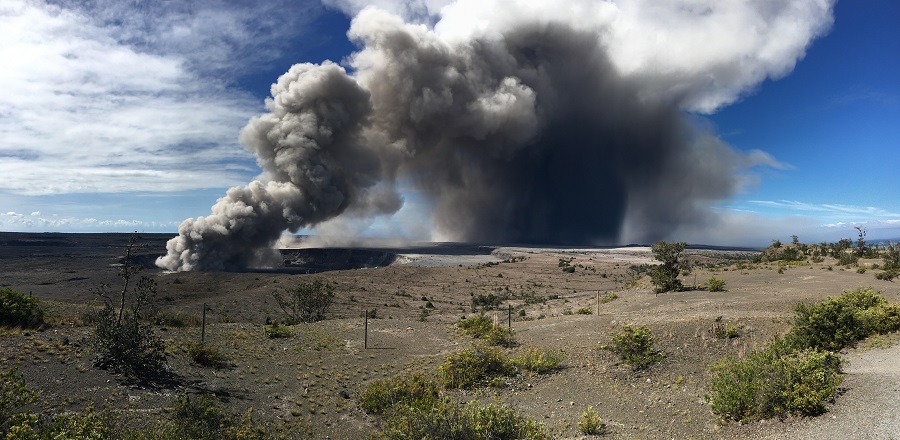
The USGS elevated it’s Orange Warning to a Red Warning yesterday due to activity at Kilauea’s summit while the Hawaii Fire Department reports that air quality is condition RED around eruptive fissures roughly 20 miles east of Kilauea’s summit. The National Weather Service had also issued an Ash Advisory for portions of Hawaii’s Big Island yesterday, but dropped it to no significant ashfall happening right now. These three warning/advisories are different and don’t include the entire state of Hawaii.
Air with Condition RED means immediate danger to health; the Hawaii County Civil Defense warns residents in the Condition RED area to take immediate action to limit further exposure. In their most recent alert issued this morning, they caution, “Severe conditions may lead to symptoms such as eye and nose irritation, and coughing. Sulfur Dioxide (SO2) gas is especially dangerous for the elderly, children/babies and people with respiratory problems.” The Red Warning at the summit isn’t tied to toxic gas though; it is tied to ash and the potential hazards it can create. Scientists have warned about the dangers associated with SO2 since the eruption began. Sulfur dioxide affects human health when it is breathed in. It irritates the nose, throat, and airways to cause coughing, wheezing, shortness of breath, or a tight feeling around the chest. The effects of sulfur dioxide are felt very quickly and most people would feel the worst symptoms in 10 or 15 minutes after breathing it in. Those most at risk of developing problems if they are exposed to sulfur dioxide are people with asthma or similar conditions. Extreme concentrations of sulfur dioxide can be deadly if inhaled. When combined with other substances additional hazards can be created; as an example, rain falling through a sulfur dioxide plume could produce an acid rainfall. Sulfur dioxide is invisible to the human eye, but when it reacts with other gases, aerosol particles can form to cause haze, and according to NASA in extreme widespread events, climate cooling.
The Red Warning issued by the USGS is for aviation interests. The Hawaiian Volcano Observatory (HVO) of the USGS said that eruption of ash from the Overlook vent within Halemaumau crater at Kilauea Volcano’s summit had increased in intensity yesterday. Throughout the day, ash had been rising nearly continuously from the vent and drifting downwind to the southwest. Ashfall and vog has been reported in Pahala, about 18 miles downwind. National Weather Service weather RADAR and pilot reports indicate that the top of the ash cloud is as high as 10,000 to 12,000 feet above sea level. Due to the potential threat ash has on aircraft, HVO assigned an aviation color code RED on Tuesday and decided to remain at RED on Wednesday. HVO says they are “anticipating further ash events which may continue for the foreseeable future. Communities downwind should expect intermittent ashfall.”
During Tuesday’s ashfall, the National Weather Service issued a Volcanic Ash Advisory for up to 1/4″ of ash over southeast and southern portions of Hawaii’s Big Island. While the advisory was dropped, new advisories could be issued if a significant plume of ash rises again from the volcano.
Volcanic ash, even in small quantities, can do some harm on the surface. A light coating on car or home windows can scratch them; great care should be used when removing ash. Ash entering water catchment systems can contaminate their contents, clog filters, and/or do harm to pumps. More substantial eruptions can also impact cars and jet aircraft, although the explosions this morning have been relatively small.
The National Weather Service says in the event Kilauea creates a large ash loud, NOAA’s Volcanic Ash Advisory Centers (VAAC) will issue critical guidance to help aircraft steer away from destructive ash particles. NOAA’s VAAC has been providing guidance on remote volcanoes erupting in/around Alaska that could pose an aviation threat too. For now, National Weather Service office in Honolulu is responsible for issuing advisories for ashfall.